仁爱版英语七年级上册第三单元第二话题知识点复习
- 格式:doc
- 大小:30.50 KB
- 文档页数:2
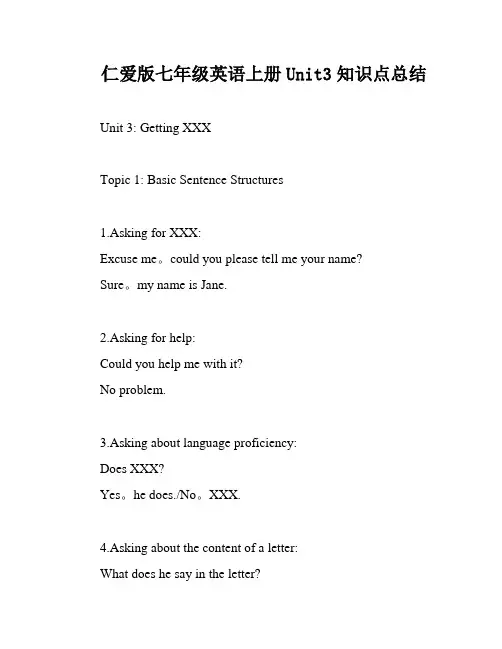
仁爱版七年级英语上册Unit3知识点总结Unit 3: Getting XXXTopic 1: Basic Sentence Structures1.Asking for XXX:Excuse me。
could you please tell me your name?Sure。
my name is Jane.2.Asking for help:Could you help me with it?No problem.3.Asking about language proficiency:Does XXX?Yes。
he does./No。
XXX.4.Asking about the content of a letter:What does he say in the letter?5.Describing friendship:Jane。
Sally。
and I are good friends.6.Describing mutual help:We often help each other.7.Expressing different degrees of liking:Many students in our class like English a lot。
but I like it a little.What about you。
Sam?No。
I don't like English at all.Useful Phrases:9.Pen palXXX11.A lot12.Not。
at all13.Each other14.A little15.Very much16.A lot of17.Every dayPersonal Pronouns and Simple Present XXXXXX or things。
and they have ns in person。
singular or plural。
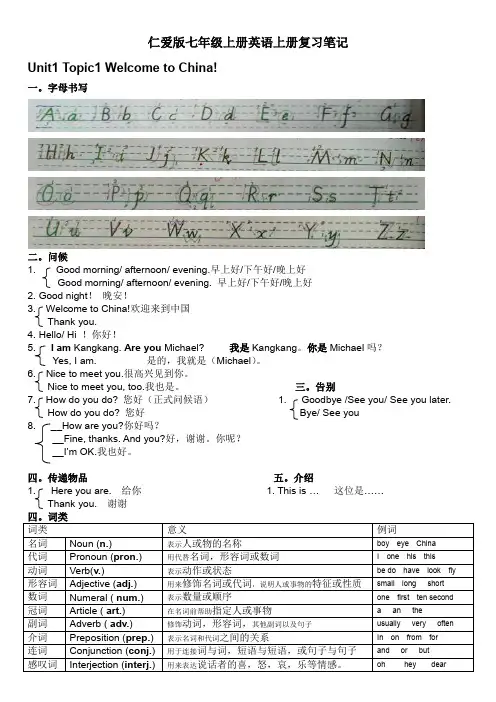
仁爱版七年级上册英语上册复习笔记Unit1 Topic1 Welcome to China!一。
字母书写二。
问候1. Good morning/ afternoon/ evening.早上好/下午好/晚上好Good morning/ afternoon/ evening. 早上好/下午好/晚上好2. Good night!晚安!3. Welcome to China!欢迎来到中国Thank you.4. Hello/ Hi !你好!5. I am Kangkang. Are you Michael? 我是Kangkang。
你是Michael吗?Yes, I am. 是的,我就是(Michael)。
6. Nice to meet you.很高兴见到你。
Nice to meet you, too.我也是。
三。
告别7. How do you do? 您好(正式问候语) 1. Goodbye /See you/ See you later.How do you do? 您好Bye/ See you8. __How are you?你好吗?__Fine, thanks. And you?好,谢谢。
你呢?__I’m OK.我也好。
四。
传递物品五。
介绍1. Here you are. 给你 1. This is …这位是……Thank you.谢谢四。
词类词类意义例词名词Noun (n.) 表示人或物的名称boy eye China代词Pronoun (pron.) 用代替名词,形容词或数词I one his this动词Verb(v.) 表示动作或状态be do have look fly 形容词Adjective (adj.) 用来修饰名词或代词,说明人或事物的特征或性质small long short数词Numeral ( num.) 表示数量或顺序one first ten second 冠词Article ( art.) 在名词前帮助指定人或事物 a an the副词Adverb ( adv.) 修饰动词,形容词,其他副词以及句子usually very often 介词Preposition (prep.) 表示名词和代词之间的关系In on from for连词Conjunction (conj.) 用于连接词与词,短语与短语,或句子与句子and or but感叹词Interjection (interj.) 用来表达说话者的喜,怒,哀,乐等情感。
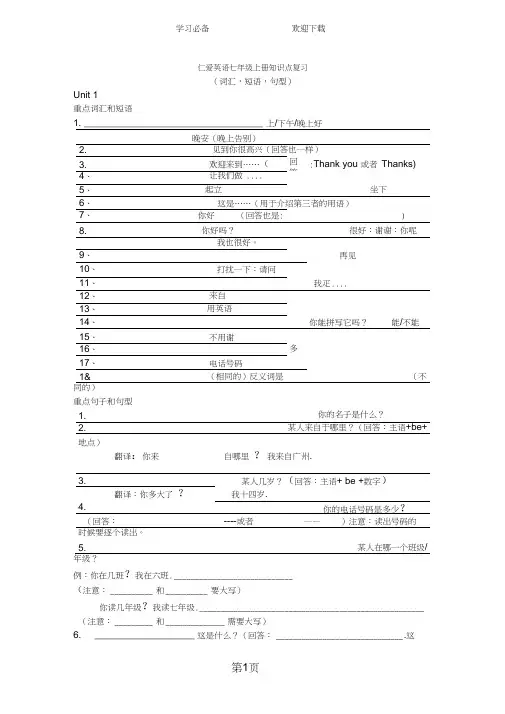
仁爱英语七年级上册知识点复习(词汇,短语,句型)Unit 1重点词汇和短语重点句子和句型1. 你的名子是什么?2. 某人来自于哪里?(回答:主语+be+ 地点)翻译:你来自哪里?我来自广州.3. 某人几岁?(回答:主语+ be +数字)翻译:你多大了?我十四岁.4. 你的电话号码是多少?(回答:----或者——)注意:读出号码的时候要逐个读出。
5. 某人在哪一个班级/ 年级?例:你在几班?我在六班. ____________________________(注意:__________ 和__________ 要大写)你读几年级?我读七年级. _____________________________________________________ (注意:_________ 和______________ 需要大写)6. ___________________ 这是什么?(回答:______________________________ .这是... )__________________________________ 这些是什么(回答:_____________________________ 这些是……)7. __________________ 你怎么拼写它?_______________________________ (注意拼读方法)Unit 2 重点词汇和短语1. sb + has/ have ( an /a ) + adj + 五官==sb' s 五官is / are + adj(描述长相)例:Lily has a small nose. = ______________________2、 ___________________ 我明白了3. That ' s right 那是对的4、______________________________ _____________________________ 起来相像_____________________________________ 看起来不同______________ 和______________ 位于be动词或情态动词后,位于行为动词前例:我们都我认为你是对的。
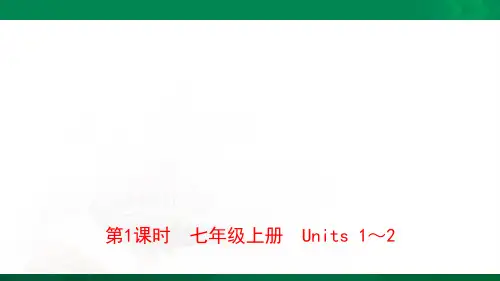


仁爱七年级上册Unit3知识点归纳和练习(2)(word版可编辑修改) 编辑整理:尊敬的读者朋友们:这里是精品文档编辑中心,本文档内容是由我和我的同事精心编辑整理后发布的,发布之前我们对文中内容进行仔细校对,但是难免会有疏漏的地方,但是任然希望(仁爱七年级上册Unit3知识点归纳和练习(2)(word版可编辑修改))的内容能够给您的工作和学习带来便利。
同时也真诚的希望收到您的建议和反馈,这将是我们进步的源泉,前进的动力。
本文可编辑可修改,如果觉得对您有帮助请收藏以便随时查阅,最后祝您生活愉快业绩进步,以下为仁爱七年级上册Unit3知识点归纳和练习(2)(word版可编辑修改)的全部内容。
第三单元知识点归纳1、Could you (please)……(后接动词原形)你愿意做某事吗?May I …… (后接动词原形) 我能做某事吗?2、 the English corner 英语角3、 live in + 地点住在某地 live with + 人和某人住在一起4、 What does he say in the letter? 他在信里说了些什么?What does he say on the photo?他在电话里说了些什么?5、 a lot = very much 放在句末,修饰动词,非常……例: I like the boy a lot/ very much。
not at all 一点也不…… 例: I d on’t like the boy at all。
.6、 each other 相互,彼此 students often talk to each other in class。
7、do sth with sb 和某人一起做某事8、No problem 没问题9、speak + 语言说某种语言 speak English speak Chinese10、 the Great Wall 长城11、come/go to + 地点去某地但home 、here 、 there 这些是副词,前面不能加to例:go home / come here / go therego to do sth 去做某事例:They go to play basketball。
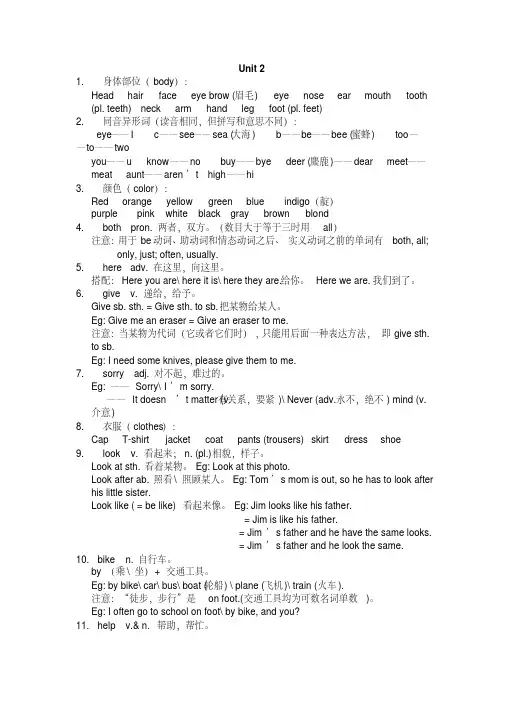
Unit 21. 身体部位(body):Head hair face eye brow (眉毛) eye nose ear mouth tooth (pl. teeth) neck arm hand leg foot (pl. feet)2. 同音异形词(读音相同,但拼写和意思不同):eye——I c——see——sea (大海) b——be——bee (蜜蜂) too——to——twoyou——u know——no buy——bye deer (麋鹿)——dear meet——meat aunt——aren’t high——hi3. 颜色(color):Red orange yellow green blue indigo(靛)purple pink white black gray brown blond4. both pron. 两者,双方。
(数目大于等于三时用all)注意:用于be动词、助动词和情态动词之后、实义动词之前的单词有both, all;only, just; often, usually.5. here adv. 在这里,向这里。
搭配:Here you are\ here it is\ here they are. 给你。
Here we are. 我们到了。
6. give v. 递给,给予。
Give sb. sth. = Give sth. to sb. 把某物给某人。
Eg: Give me an eraser = Give an eraser to me.注意:当某物为代词(它或者它们时),只能用后面一种表达方法,即give sth.to sb.Eg: I need some knives, please give them to me.7. sorry adj. 对不起,难过的。
Eg: ——Sorry\ I’m sorry.有关系,要紧)\ Never (adv.永不,绝不) mind (v.——It doesn’t matter (v.介意)8. 衣服(clothes):Cap T-shirt jacket coat pants (trousers) skirt dress shoe9. look v. 看起来;n. (pl.)相貌,样子。
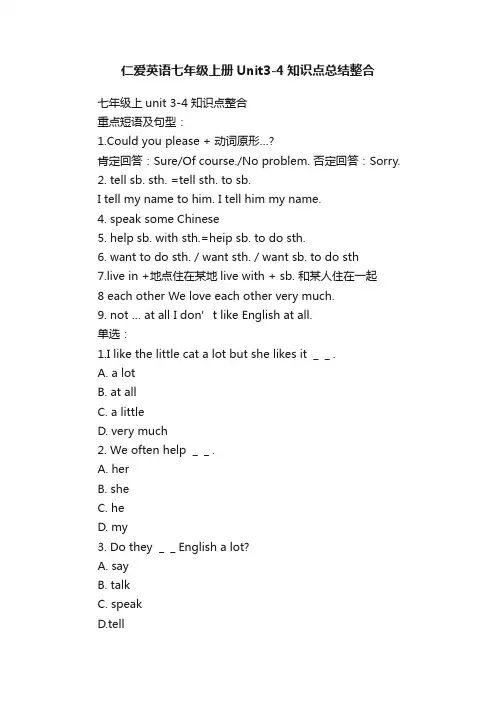
仁爱英语七年级上册Unit3-4知识点总结整合七年级上unit 3-4 知识点整合重点短语及句型:1.Could you please + 动词原形…?肯定回答:Sure/Of course./No problem. 否定回答:Sorry.2. tell sb. sth. =tell sth. to sb.I tell my name to him. I tell him my name.4. speak some Chinese5. help sb. with sth.=heip sb. to do sth.6. want to do sth. / want sth. / want sb. to do sth7.live in +地点住在某地live with + sb. 和某人住在一起8 each other We love each other very much.9. not … at all I don’t like English a t all.单选:1.I like the little cat a lot but she likes it __.A. a lotB. at allC. a littleD. very much2. We often help __.A. herB. sheC. heD. my3. Do they __English a lot?A. sayB. talkC. speakD.tell4. He ------to visit China.A. wantB. to wantC. w antsD. don’t want5. ---- Could you give me an apple? ----__. I have three.A. Sorry.B. Thank youC. No problemD. Please句型转换:1.我想在英语方面帮助他I __to help him__his English.2. Kate likes the food. 用not… at all 改写Kate__like the food ____.3. I often help him and he often helps me. 合为一句He and I often help ____.4. She lives in the U.S.A. 对划线部分提问____she live?Topic 2重点短语及句型:1. be home/at home/go home/get home2. Glad to meet you.3. have a seat4. What do/ doe s sb.do? =What is sb.?=What’s one’s job?Sb + be + 职业6. in a hospital / in hospitalHe works in a hospital. He is ill in hospital.on a farm/ in a school / in an office/ in a factory / in a shop/ in a restaurant/ at homeAt, in 两个介词接地点时的区别At 常表示的位置是某一个具体的地点,一般用来指比较小的地方,如车站,村庄,建筑物,城镇等At school gate/ at the stationIn一般指大地方,如大城市,省,行政区,国家等如In shangha/ in the USA7. family 作为整体概念在句中作主语时,谓语动词用单数形式。
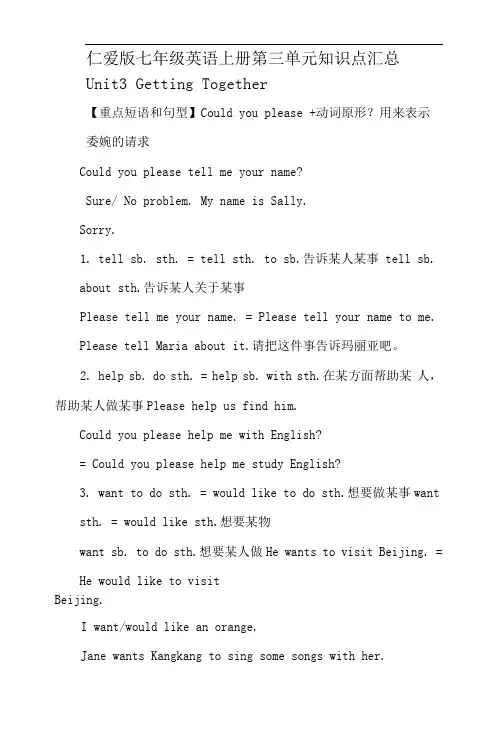
仁爱版七年级英语上册第三单元知识点汇总Unit3 Getting Together【重点短语和句型】Could you please +动词原形?用来表示委婉的请求Could you please tell me your name?Sure/ No problem. My name is Sally.Sorry.1.tell sb. sth. = tell sth. to sb.告诉某人某事 tell sb.about sth.告诉某人关于某事Please tell me your name. = Please tell your name to me.Please tell Maria about it.请把这件事告诉玛丽亚吧。
2.help sb. do sth. = help sb. with sth.在某方面帮助某人,帮助某人做某事Please help us find him.Could you please help me with English?= Could you please help me study English?3.want to do sth. = would like to do sth.想要做某事wantsth. = would like sth.想要某物want sb. to do sth.想要某人做He wants to visit Beijing. =He would like to visitBeijing.I want/would like an orange.Jane wants Kangkang to sing some songs with her.4.show sth. to sb. = show sb. sth.把某物展示给某人看Maria shows a photo of her family to Kangkang.5.My English is very good. =1 can speak English very well.6.live in+地点居住在某地live with + sb. 和某人住He live in China with his parents.7.know a lot about 知道许多关于的事He knows a lot aboutChina.8.say表示说话的内容,speak表示说某种语言的能力Whatdoes he say in the letter?He can speak some English.9.对事物的喜欢程度likevery much/a lot 非常喜欢like……a little有点喜欢don' t likeat all 一点都不喜欢Many students in our class like English a lot, but Ilike it a little.He doesn' t like chocolate at all.10.a lot of+可数名词复数/不可数名词I have a lot ofEnglish books.11.every day 每天each other 相互some of them他们中的一些eat out下馆子,到外面吃饭12.play with sb.和某人一块玩耍like to do/doing sth.喜欢(做)某事She likes to play with Kitty.13.Help yourself/yourselves to sth.随便吃(喝)be kindto sb.对某人很友好They are all kind to me.他们对我很友好。
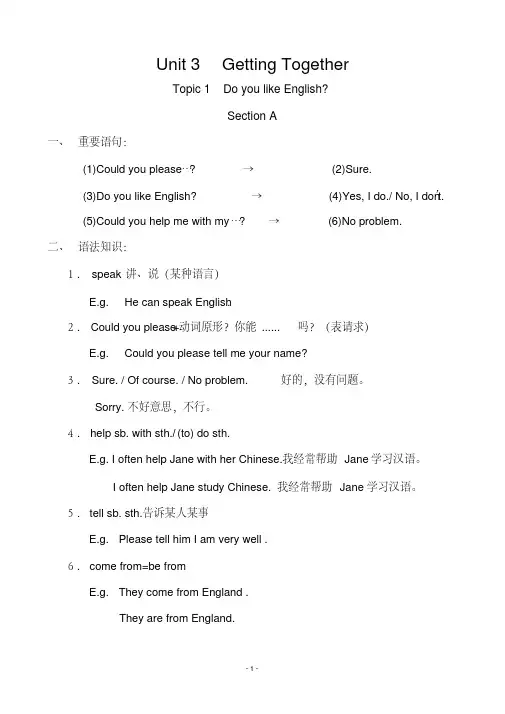
Unit 3 Getting TogetherTopic 1 Do you like English?Section A一、重要语句:(1)Could you please …?→(2)Sure.(3)Do you like English?→(4)Yes, I do./ No, I don’t.(5)Could you help me with my …?→(6)No problem.二、语法知识:1.speak 讲、说(某种语言)E.g. He can speak English .2.Could you please+动词原形?你能......吗?(表请求)E.g. Could you please tell me your name?3.Sure. / Of course. / No problem. 好的,没有问题。
Sorry.不好意思,不行。
4.help sb. with sth./(to) do sth.E.g. I often help Jane with her Chinese. 我经常帮助Jane学习汉语。
I often help Jane study Chinese. 我经常帮助Jane学习汉语。
5.tell sb. sth.告诉某人某事E.g. Please tell him I am very well .6.come from=be fromE.g. They come from England .They are from England.7.在英语句子中,如果主语是第三人称单数,那么在动词后加-SE.g.You like English . He likes English .变为疑问句和否定句时,加does并把动词改为原型:E.g.He does not like English .Does he like English ?8. like 可以作动词,意思是喜欢。
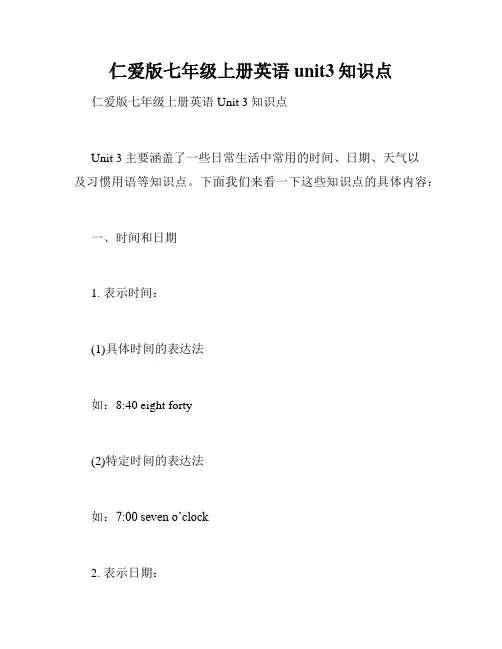
仁爱版七年级上册英语unit3知识点仁爱版七年级上册英语Unit 3知识点
Unit 3主要涵盖了一些日常生活中常用的时间、日期、天气以
及习惯用语等知识点。
下面我们来看一下这些知识点的具体内容:
一、时间和日期
1. 表示时间:
(1)具体时间的表达法
如:8:40 eight forty
(2)特定时间的表达法
如:7:00 seven o’clock
2. 表示日期:
(1)日期的表达法:
如:September 9th
(2)缩略词的使用:
如:Sept.9th
二、天气
1. 询问天气:
What’s the weather like today?
2. 回答天气:
It’s sunny/cloudy/rainy/windy.
三、习惯用语
1. 在学校
(1)上课: Have a class
(2)接受——做功课: Do homework
2. 家庭生活
(1)洗衣服: Do the laundry
(2)做饭: Cook
以上就是Unit 3的主要知识点,大家可以结合教材内容及时练习,加强自己的语言应用能力。
完成Unit 3的学习后,同学们不仅能够掌握基本日常用语,而且能够运用所学知识进行日常生活中的交流。
仁爱版七年级上册英语上册复习笔记Unit1 Topic1 Welcome to China!一。
字母书写二。
问候1. Good morning/ afternoon/ evening.早上好/下午好/晚上好Good morning/ afternoon/ evening. 早上好/下午好/晚上好2. Good night!晚安!3. Welcome to China!欢迎来到中国Thank you.4. Hello/ Hi !你好!5. I am Kangkang. Are you Michael? 我是Kangkang。
你是Michael 吗?Y e s, I am. 是的,我就是(M ichael)。
6. Nice to meet you.很高兴见到你。
Nice to meet you, too.我也是。
三。
告别7. How do you do? 您好(正式问候语) 1. Goodbye /See you/ See you later.How do you do? 您好Bye/ See you8. How are you?你好吗?Fine, thanks. And you?好,谢谢。
你呢?I’m OK.我也好。
四。
传递物品五。
介绍1. Here you are. 给你 1. This is …这位是……Thank you. 谢谢四。
词类词类意义例词名词Noun (n.) 表示人或物的名称boy eye China代词Pronoun (pron.) 用代替名词,形容词或数词I one his this动词Verb(v.) 表示动作或状态be do have look fly形容词Adjective (adj.) 用来修饰名词或代词,说明人或事物的特征或性质small long short 数词Numeral ( num.) 表示数量或顺序one first ten second冠词Article ( art.) 在名词前帮助指定人或事物 a an the副词Adverb ( adv.) 修饰动词,形容词,其他副词以及句子usually very often 介词Preposition (prep.) 表示名词和代词之间的关系In on from for连词Conjunction (conj.) 用于连接词与词,短语与短语,或句子与句子and or but感叹词Interjection (interj.) 用来表达说话者的喜,怒,哀,乐等情感。
仁爱版七年级上册unit3 知识点仁爱版七年级上册Unit 3 知识点随着学习的深入,学生们需要掌握越来越多的知识点,特别是在初中阶段,这一点尤为重要。
本文将介绍仁爱版七年级上册Unit 3 的知识点,帮助学生们更好地掌握该单元知识。
一、动词的分类与用法在英语中,动词是一个十分重要的词类,它用来表示动作或状态。
根据词性分类,有不及物动词和及物动词。
不及物动词不需要宾语,例如:run、swim,而及物动词需要宾语,例如:read book、watch TV。
在动词的用法中,还需要学习动词的时态和语态,例如:一般现在时、一般过去时、现在进行时、过去进行时等等。
同时,动词还有被动语态、进行时态和完成时态等语态。
二、介词的基本用法介词是一个连接词,用来表示两个词之间的关系,例如:onthe table、under the chair。
介词的基本用法包括表示时间、地点、方式等。
在使用介词时,需要注意介词与后面的名词或代词之间的正确搭配,例如:in the morning、at night、on the bus等等。
三、数词的用法数词是表示数量的词,包括基数词、序数词和分数词。
其中,基数词用来表示数量的多少,例如:one、two、three;序数词用来表示位置,例如:first、second、third;分数词用来表示分数,例如:one third。
在使用数词时,需要注意其在句子中的位置和拼写形式。
例如:I have two cats、He is the first in the race、One half is equal to two quarters。
四、特殊疑问句特殊疑问句是用来询问特定信息的问句,例如:What’s your name?、Where do you live?、Who is your teacher?、How do you feel?、When is your birthday?、Why do you like English?。
Unit3Getting TogetherTopic2What does your mother do?知识点梳理(一)单词1.职业名称teach(教)→teacher(教师)work(工作)→worker(工人)drive(驾驶)→driver(司机)farm(农场)→farmer(农民)act(表演)→actor演员2.对应词:teacher老师—student学生nurse护士—doctor医生waiter男服务员—waitress女服务员salesman男售货员—salesgirl女售货员3.家庭成员grandfather--grandmother grandpa--grandma father--motherdad--mum uncle---aunt son---daughter brother---sistercousin(二)词组1.工作场所:in a school在学校in a hospital在医院in an office在办公室in a shop/store在商店on a farm在农场at home在家2.be home到家3.a photo of my family一张我家的相片4.the young woman in yellow穿黄衣服的年轻女士5.on the sofa在沙发上6.a happy family幸福的家7.a student in Grade Seven一名七年级的学生8.live in…居住在9.live with…和……住在一起10.look after…照顾……;保管……(三)句型:1.I'm home.我回来了2.What a nice place!多漂亮的一个地方!3.There are five people in my family.我家有五口人。
There be…“有……”,表示“某处有某人/物”,be动词的单复数形式根据所跟名词的单复数一致;people单复数同形。
Unit 3 topic2
重点单词
Teach---teaches
重点短语:
到家,在家be home
欢迎来到某地welcome to
一个办公室工作人员an office worker
在医院in the hospital
在农场on the farm
在办公室in an office
一张...的照片 a photo of
穿黄色衣服的年轻女人the young woman in yellow
在沙发上on the sofa
家谱family tree
居住在某地live in
和某人居住在一起live with
喜欢做某事like to do sth
和某人一起玩耍play with
重点句型:
1.你的妈妈是做什么的?她是一个老师, (写出同义句)
What does your mother do? She is a teacher.(要学会用不同的人称举一反三)
What is your mother? She is a teacher.
2.你妈妈在哪里工作?她在医院工作。
Where does your mother work? She works in a hospital(要学会用不同的人称举一反三)
3.很高兴见到你及其答语
Glad/Nice to meet you! Glad/Nice to meet you,too
4.她在一个学校教英语
She teaches English in a school. (注意单三式)
5.这是康康家的一张照片
This is a photo of Kangkang’s family
6.那个穿黄色衣服的年轻女人是谁?她是我婶婶。
Who is the young woman in yellow? She is my aunt. (特殊疑问句,要举一反三)
7.那个穿红色衣服的年轻女人是你的妈妈吗?是的,她是我妈妈Is the young woman is red your mother? Yes,that’s my mother(一般疑问句举一反三)
8.你有一个大家庭
You have a big family
9.我的祖父母和我们住在一起
My grandparents live with us
10.她喜欢和猫玩耍
She likes to play with the cat
11.我爱我家
I love my family
作文预测描述一张照片,介绍某个人
可以用到的一些表达
This is a photo of.....’s family,the young woman in...is his....
His ...is in a/an....... ....love his family (都是一些相同的句型,可以把其他单元学习的知识点整合在里面)
重要语法
实义动词的一般现在时,特殊疑问句、一般疑问句、否定句需要借助助动词:Do/does,do 和does 根据人称确定。
特殊疑问句:
你父母是干什么的?What do your parents do?
你父母在哪里工作?Where do your parents work?
一般疑问句
你爸爸在医院工作吗?Does your father work in a hospital?
否定句
我爸爸没有在医院工作My father doesn’t work in a hospital。